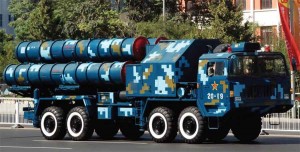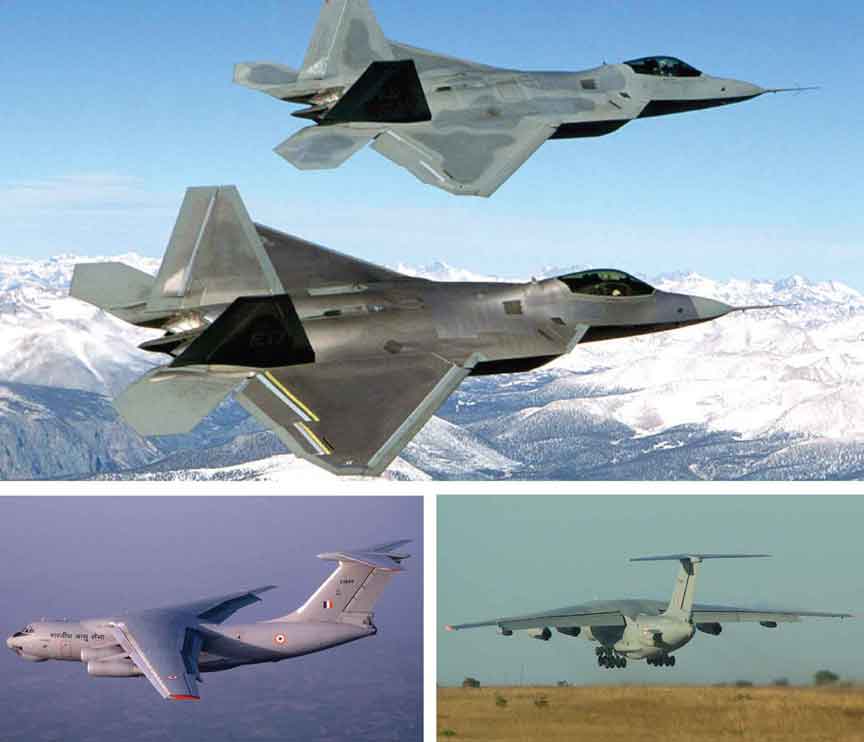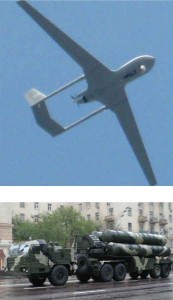Areas of Concern
China’s use of its military in the ‘disputed territories’ to continually flag its territorial agenda is a distressing thorn in India’s side. Although the civilian establishment tends to play it down perhaps to avoid the action it would be forced to take if the whole extent of the intrusions and transgressions into Indian territory became public, the military establishment faces affront incessantly.
The gradual militarisation of Tibet and the building of infrastructure there is another area of concern for India…
The brazenness and frequency of Chinese aggressive encroachments is on the increase. It is this author’s prediction that the PLAAF flights over Indian territory using manned and unmanned craft, as an analogous extension to misdemeanours on the ground, are a distinct and near proximity. The concern is that such over flights are unlikely to be countered by India on the basis of decisive rules of engagement due to lack of a political will.
The gradual militarisation of Tibet and the building of infrastructure there is another area of concern for India. The rail head at Lhasa, connecting it to Xining, the capital of Qinghai province, over a distance of 1,956 km, has stated economic motivations. However, its strategic import cannot be ignored. There are 14 airfields in Tibet which can support operations in the Himalayan region. Their significance to any PLAAF operations against India is self-evident. Air-to-air refuelling capabilities of the PLAAF render operational ranges menacing for India.
Meanwhile, China’s manufacturing industry in the military and commercial aviation domain has made significant advances. It would be imprudent to treat this capability with scorn just because it is based on reverse engineering or industrial espionage. Notwithstanding such criticism, Chinese indigenous capability to develop and produce improved versions of older aircraft and new designs of modern fourth and fifth generation fighters and attack helicopters, is a cause of concern. This is especially so as Indian growth in this area remains stunted. The Hindustan Aeronautics Limited (HAL) and National Aeronautics Limited (NAL) are yet to produce an aircraft design of note. The only passenger aircraft design (Saras) is on a “time out” after the crash of its second prototype while the Tejas, the only modern fighter design by HAL, is delayed by over two decades. All indicators are that when it finally does enter service with an IAF reluctant to accept it, it will be a type best described as “too little, too late”.
The Dhruv is yet to draw appreciative remarks from any of its users. HAL’s contribution to Indian manufacturing industry can be best described as “licensed production”. China, on the other hand, has invested in high-precision and technologically advanced machine tools, avionics and other components that can also be used in the production of civil and military aircraft. Infrastructure and experience for the production of large-body commercial and military aircraft are believed to be limited but growing steadily. China is developing fourth and fifth generation aircraft that incorporate stealth and low observable technologies including carbon composites. Perhaps the only area it lags in is the production of reliable high performance aircraft engines. Given its track record and its single minded pursuit of self sufficiency, it is only a matter of time when that capability is also attained by China.
As long as HAL continues to exist in its present avatar, India is unlikely to approach the leading edge of aircraft design and technology…
Implications for India
Although a quantitative comparison is not the best way to evaluate contending air forces, one cannot ignore the numbers altogether. According to a 2012 Pentagon report, the PLAAF has 1,570 fighters, 550 bombers, 300 transport aircraft plus another 1,450 older aircraft in its inventory. Of the fighters, more than 400 are in the fourth generation class and by 2020, this number is expected to go up to 1,000 which would be around half of the combat aircraft holding. The PLAAF has always had more aircraft than the Indian Air Force (IAF). However, in the early years of the PLAAF, the quality of aircraft on its inventory was poor and ineffectual. In recent years, the quantitative edge has continued to be in favour of China while the qualitative advancements made by it have rendered it that much more potent. As India has produced no aircraft of its own, it has been dependent on Russian and Western sources. The purchase of these aircraft has not given any technological education as a benefit and licensed production has been the norm.
Even the ongoing negotiations for the Medium Multi-Role Combat Aircraft (MMRCA) Rafale, despite the new defence procurement policy, may not achieve a high score on the relevant technology transfer. As long as HAL continues to exist in its present avatar, India is unlikely to approach the leading edge of aircraft design and technology. The establishment does not seem capable of comprehending the obvious fact that an Indian state-managed Public Sector Unit (PSU) is not capable of achieving what the Chinese aviation manufacturing industry has achieved. Privatisation of aviation manufacturing could have been a solution but an unlikely one due to the strong lobby HAL enjoys at the centre which has allowed it to exist despite patent inefficiencies and incompetence. The Indian military aviation industry has suffered long on this count and future confrontations with PLAAF are guaranteed to bring to the fore our failure as a fairly advanced nation to produce an inexpensive, indigenous and potent aircraft.
)”] The IAF’s vision for what it wants to be is clear but its execution is clouded by India’s apparently flawed national policies. The MMRCA is a long suffering story the IAF would like to forget. The travesty therein is that while the IAF is responsible for the air defence of the country and offensive roles against belligerent neighbours, what aircraft and equipment it gets for doing its job is tempered by a bureaucracy that is more concerned with the process of procurement than the speed and efficacy with which the right hardware is made available to the IAF. The consequence of delays in the procurement of the MMRCA and the entry of the Tejas into service will be that the IAF would become woefully inadequate to meet with the task of engaging the PLAAF in an honourable contest. Should aerial confrontation accrue between India and China in the near future, it is almost certain that the IAF would suffer the same fate of ignominy that our ground forces did in 1962.
The IAF’s vision for what it wants to be is clear but its execution is clouded by India’s apparently flawed national policies. The MMRCA is a long suffering story the IAF would like to forget. The travesty therein is that while the IAF is responsible for the air defence of the country and offensive roles against belligerent neighbours, what aircraft and equipment it gets for doing its job is tempered by a bureaucracy that is more concerned with the process of procurement than the speed and efficacy with which the right hardware is made available to the IAF. The consequence of delays in the procurement of the MMRCA and the entry of the Tejas into service will be that the IAF would become woefully inadequate to meet with the task of engaging the PLAAF in an honourable contest. Should aerial confrontation accrue between India and China in the near future, it is almost certain that the IAF would suffer the same fate of ignominy that our ground forces did in 1962.
Future confrontations with PLAAF will bring to the fore our failure to produce an inexpensive, indigenous and potent aircraft…
Conclusion
The ‘inscrutable’ sobriquet for the Chinese is not so much because of their unsmiling faces but on account of their unpredictable actions. Military action against India may not come in the form of a full-fledged war. Small pin pricks in ‘disputed territories’ may keep increasing in magnitude and frequency until even the submissive and cautious Indian government is constrained to react. Should that happen and a larger military confrontation become inevitable, the PLAAF would be a major instrument of damage to our forces, assets and national pride.
Some writings on the 1962 conflict include views that the IAF could have done considerable damage to the Chinese as the PLAAF had outdated aircraft and equipment then. The same is not true about the PLAAF today. The continuing delays in updating capabilities of the IAF relentlessly bring us closer to the possibility of a humiliating experience at the hands of the PLAAF.







The Chinese are spreading their wings and testing the waters with all the countries in the region. The first country they tested was India, one of the strongest powers in Asia and having the third largest Army in the world. Remember DBO; they intruded nearly 30 kms, while our response was whining about peaceful solutions. Why ? Because the civilian government doesn’t have balls and the armed forces aren’t prepared; they are ill equipped as of date. The end result was a squabble between the Army and the ITBP. That was all that we were capable of doing. Now as far as the Airforce is concerned it’s far behind the PLAAF now. It’s about time one of the Air Chiefs resigned over the dismal state in which the Air Force is in. We are down to 30 + squadrons against a projected 40 + squadrons. A question to the Air Force; whats the Operational capability of these 30 + Squadrons. Is it 100%? Sadly I don’t think so. So that’s where we stand. About the transport fleet less said the better. What’s a few C-130s and C-17 ? They in reality do not add any strategic advantage to Air Borne or Air Transport operations. All An-32s have lived out their life. Why is the Air Force is such a state of affairs – somebody has to answer. HAL is the sad boy in the whole game? Typical DRDO stuff; to produce a piece of equipment that was out dated at least 15 years back. Why doesn’t the Air force make noise about it? Like the Army was dumped with an out dated weapon called the INSAS the Air Force will get the Tejas. We need at least 60 Squadrons of Fighter Aircraft with 70 % oriented towards Air Superiority Role and 30 % as FGA and over lap of 20 % multi role aircraft. And as part of modernisation we need an Air Defence and Aero Space Command to keep our sky’s monitored and clear 365 days. Its a wake up call for everybody or else 62!!
Quite an eye opening article. Secially with the names and designations of new Chinese fighter jets. The Chinese have copied almost every kind of aircraft available in the Soviet amd the US inventory. Definitely agreed that the Indian government needs to take a tougher stand for the well being of our Air-Force.
That said, China is definitely up to something big. The way its expaning the armed forces is alarming.
India’s national security is threatened and lest we act, 1962 may be repeated.
It seems the US is copying Chinese designs. What a shame !!!
The group captain and his colleagues from the IAF should tell the government that they cannot manage the responsibilities expected of them especially regarding tackling of the PLAAF. The GoI that they should disband the IAF and handover the responsibility to the Army and Navy who I am sure will rise to the occasion. I am sure the navy at least knows that India cannot fight the chinese based on imported equipment . I am hereby expressing my lack of confidence in the IAF managing their role properly. The IAF has done enough damage already to the country by sabotaging indigenous efforts.
Your writing is woefully off the point. The author has just presented his views. What makes you think that IAF has never risen or performed their duties properly? Instead of focussing on the mostrous, useless HAL, NAL and ADA located out of Bangalore where so-called engineers go only as a 2 year training school and then go abroad, you are attacking the IAF. How much more dumb can it get man? IAF is better managed than Indian Navy who keeps on blowing the most expensive submarine in dock and grounding their fighting ships every now and then. He is dot on the mark and hs said what Indian babus and those in the useless companies HAL, NAL and ADA have never heard: Shut it down!
Capt Suchdeve’s comments are well researched, however, debatable on specifics. The lesson for India is to get back to the basics, meaning, accelerated application of latest technologies in the indigenous military hardware and the science of theatre command and control. It is pointless to worry about man to man or gun to gun comparison. There will remain budgetary constraints and India cannot match the numbers with China, at least for several decades. India’s focus must remain on building quality in hardware and delivery system superior to China so that command and control can strike the right punch when and where ordered by a civilian authority. India’s response must remain stealthy in intensity and magnitude to extract maximum deterrent impact. If this seems like a tall order, take a lesson from the Israeli defense forces. A tiny nation that destroyed the military muscle of Egypt, Jordan, Syria, Lebanon within few days of the war with resources a fraction of the Arab adversaries.
Do not get carried away by the propaganda which the Chinese put out. They have stolen technologies or reverse engineered hardware. These are half as good as the real stuff. The irony is that Chinese political system does not permit questioning of the huge propaganda about their successes is put out. Take for example J-15 naval version of the Russian origin fighter. The latter dumped it in favor of Mig 29K. Chinese bought one copy in Ukraine and reverse engineered. Its published statics are impressive. In reality it cannot take off the Carrier with more than 2 tons of load. The published data by the Chinese in 8 tons. Like this there are numerous examples including some in the above write up.
Look up the attack helicopters manufactured by the Chinese aircraft companies before making such a stupid comment. The important thing is they have capability to reverse engineer an entire aircraft of Mig-21 or Su-30 MKK level with few airframes instead of HAL who needs a detailed manual for screw by screw assembly called as license production. Sycophant.